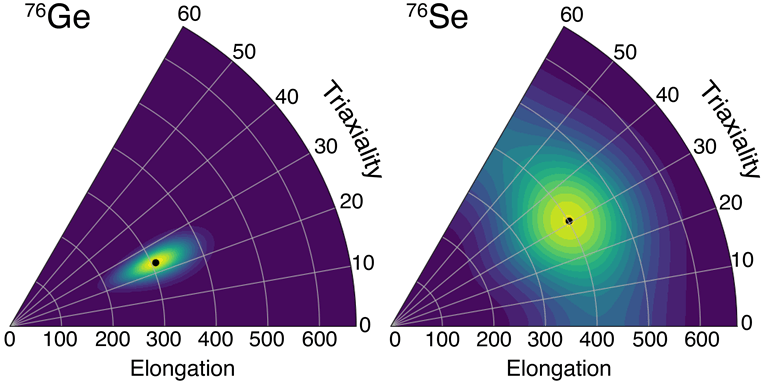For decades, scientists have been fascinated by the elusive nature of neutrinos, the ghostly particles that pervade the universe.

An elongation versus departure from axial symmetry (triaxiality) plot showing distinctive differences in the shapes of the parent (germanium-76, “rigid”) and daughter (selenium-76, “soft”) nuclei for neutrinoless double beta decay. Image Credit: Jack Henderson, University of Surrey
The true mass of neutrinos and whether the neutrinos exist as both matter and antimatter are two of the many unanswered questions in science. These mysteries may be solved by studying a phenomenon known as neutrinoless double beta decay (0νββ). In this research, germanium-76 (76Ge), one isotope, has become important. Understanding the structure and characteristics of 76Ge helps to clarify whether or not neutrinos are both matter and antimatter, as well as how they acquire mass.
The Impact
It was revolutionary to find that neutrinos have mass. The neutrinos’ exact mass is still unknown, though. Experiments involving neutrinoless double beta decay seek to establish whether neutrinos are their own antiparticles and, if so, offer a way to calculate the mass of the relevant neutrino species.
Scientists must comprehend the characteristics of 76Ge’s decay into selenium-76 (76Se) in order to determine the mass using neutrinoless double beta decay experiments utilizing 76Ge. A crucial component for these kinds of experiments is provided by the current study.
Summary
Neutrinoless double beta decay (0νββ) experiments based on germanium have a lot of potential to solve the mysteries of neutrinos. If the probability governing the decay is known with sufficient accuracy, then the observation of this unusual decay process not only provides the possibility of determining the nature of these mysterious particles but also allows one to determine the mass.
Since this probability cannot be directly observed in an experiment, it can only be calculated theoretically. Even though there are still large differences in probability values determined by various theoretical approaches, there has been a notable advancement in the understanding of and attempts to reduce these discrepancies.
Research has indicated that deformation (deviation from sphericity) and, thus, the nuclear shape have a major influence on these decay probability values among the structure effects studied. Scientists specifically anticipate a higher probability for nuclei with similar deformations but a lower probability when the parent and daughter nuclei take on different shapes.
Additionally, assuming spherical symmetry in both the parent and daughter nuclei, scientists find a maximum value.
Scientists at Triangle Universities Nuclear Laboratory (TUNL) have conducted research on the structure of 76Ge and have discovered that the 76Ge (parent) and 76Se (daughter) have distinct shapes. Specifically, the experiment demonstrated that the ground state of 76Se is characterized by a soft triaxial potential, whereas the ground state of 76Ge exhibits rigid triaxial deformation. These results are significant for calculations trying to find the relevant probability for the decay of 76Ge 0Λββ.
This work is supported by the Department of Energy Office of Science, Office of Nuclear Physics, and the National Science Foundation.
Journal Reference
Ayangeakaa, A. D., et al. (2023) Triaxiality and the nature of low-energy excitations in Ge 76. Physical Review. doi.org/10.1103/physrevc.107.044314.